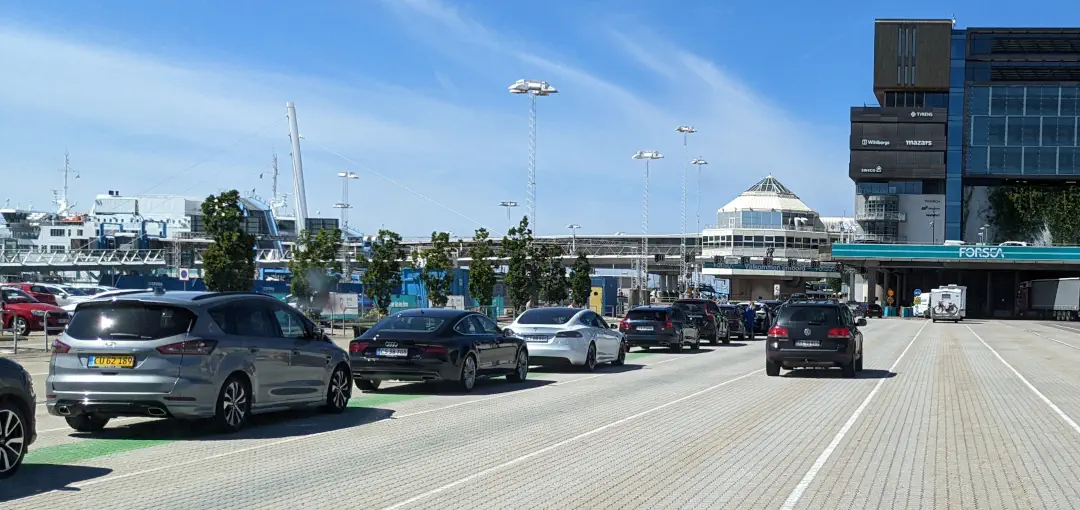
With the electric car to Ferry? No problem!
Driving an electric car to Ferry can be a great way to travel longer distances while protecting the environment. However, it is important to plan the booking and preparation carefully to ensure a safe and smooth crossing. It is even possible to charge your electric car at Ferry. In this guide, we will give you tips on how to be best prepared to drive your electric car to Ferry.
Inhaltsverzeichnis
Booking & Preparation
Before you set off on your journey, you should make sure that your Ferry will take your electric car with you. Currently there are very few exceptions (Havila Kystruten & Höegh Autoliners). All other shipping companies we know of will be very happy to take you and your electric car! Charging facilities on board, charging before departure
On board the Ferry
Once you’re on board, you should park your electric car safely. On new ferries such as the new Peter Pan and the new Nils Holgersson from TT-Line there are already charging facilities on board the Ferry.
Also on the new England ferries from Irish Ferries or the Stena Line Ferry Scandinavica from Kiel to Gothenburg, charging is also possible on board. Other shipping companies will also soon offer the loading option. However, the charging stations on the crossing should be booked in advance.
If you have booked the charging option, the staff at Ferry will direct you to your parking space. There you can connect your vehicle to the charging station and start the charging process.

The new TT-Line Ferry Nils Holgersson coming from Trelleborg, entering the port of Rostock
Depending on the duration of the crossing, it should be enough to recharge your electric car when you reach your destination port.
ferries with charging facilities on board
| Shipping company & routes | Ferries | Charging stations & costs | to the booking |
|---|---|---|---|
| TT-Line | Nils Holgersson | 32 stations Type 2 & CCS with 11-40kW €33 per vehicle |
TT-Line book |
| Fjord Line | Fjord FSTR | 16 charging stations Type 2 with 22kW €13 per vehicle |
Fjord Line book |
| Irish Ferries | MV Ulysses
MV Oscar Wilde |
3-6 charging stations Type 2 with 3.7-7kW €15 per vehicle (Cherbourg-Dublin) €0 per vehicle (Holyhead-Dublin) |
Irish Ferries book |
| Stena Line Kiel-Gothenburg |
Stena Scandinavica | 6 charging stations at 3 charging stations Type 2 with 22kW each € 25 per vehicle |
Stena Line book |
| Bornholmslinjen Ystad-Rönne |
Fast ferries | 2 charging points at 2 charging stations Type 2, power not known DKK 99 (approx. €13.25) |
After the crossing
Upon arrival at your destination port, you will have normal access to your electric car, just like all other travelers. If you have used the charging option on board, disconnect the power supply and stow all charging cables in your vehicle. For your onward journey, you should find out in advance about the charging infrastructure at your destination.

The Stena Line Ferry Stena Germanica.
FAQ about the ferry ride with the electric car
Are electric cars allowed on ferries?
We can answer that with a clear “YES”. You can use all ferry connections known to us with your electric car in the same way as with a normal combustion vehicle. It doesn’t matter whether your electric vehicle is a pure electric car (BEV) or a plug-in hybrid (PHEV).
Can I book a ferry crossing with my electric car?
Yes, this is possible without any problems. Book the crossing with your electric car as you are used to.
How do I book a Ferry for my electric car?
Bookings with charging facilities for electric cars are currently only possible directly via the shipping companies:
- Ferry Book Rostock-Trelleborg with TT-Line
- Ferry Book Swinoujscie-Trelleborg with TT-Line
- Ferry Travemünde-Book Trelleborg with TT-Line
- Ferry Book Hirtshals-Kristiansand with Fjord Line
- Ferry Book Holyhead-Dublin with Irish Ferries
- Ferry Book Cherbourg-Dublin with Irish Ferries
- Ferry Kiel-Book Gothenburg with Stena Line
For all other bookings, including those with an electric car but without charging facilities, you can simply use the following travel search with booking form:
Can I charge my electric car during the crossing?
Yes, there are already charging facilities on board ferries. Further up in the article you will find a list of the few shipping companies that already allow charging on board. At many ports you can also use the waiting time before boarding to charge your electric car in port.
How much does charging cost at Ferry?
The cost of charging your electric car on Ferry varies greatly. From the free offer on the Holyhead-Dublin route from Irish Ferries to €35 on the new TT-Line ferries , the range is quite wide. However, the duration of the crossing on the respective route and the charging capacity of the stations must also be taken into account. In the following table you will find an overview of the costs for e-car charging on Ferry:
| Operator | Route | Travel time | Charging current | possible load per trip | Cost per charge |
Cost per kWh |
|---|---|---|---|---|---|---|
| TT-Line | Travemünde-Trelleborg | 8 hours | 20kW | 160kW | 33,00 € | 0,21 € |
| TT-Line | Rostock-Trelleborg | 6 hours | 20kW | 120kW | 33,00 € | 0,28 € |
| TT-Line | Świnoujście-Trelleborg | 6 hours | 20kW | 120kW | 33,00 € | 0,28 € |
| Fjord Line | Hirtshals-Kristiansand | 2,5 hours | 22kW | 55kW | 13,00 € | 0,24 € |
| Irish Ferries | Holyhead-Dublin | 3 hours | 7kW | 21kW | 0,00 € | 0,00 € |
| Irish Ferries | Cherbourg-Dublin | 19 hours | 3,7kW | 70,3kW | 15,00 € | 0,21 € |
| Stena Line | Kiel-Gothenburg | 14 hours 30 minutes | 22kW | 319kW | 25,00 € | 0,08 € |
The possible charge is calculated from the duration of the journey and the maximum possible charging current, but can of course vary slightly. The cost per kWh is calculated by dividing the cost of the booked charge by the possible charge per crossing. Deviations are also possible here.
Current discussions about electric car ban on Havila “ferries”
First of all, it should be noted that this is a great exception. With all major shipping companies, you can easily take your electric car with you on the Ferry and in some cases even charge it during the crossing. The Norwegian shipping company Havila Kystruten is an exception here. The shipping company currently prohibits the carriage of electric vehicles. However, Havila is not a real ferry company, but rather serves the Norwegian Post as a cruise company. The Havila ships also only have space for 9 cars at a time and transportation is only possible on the Bergen-Kirkenes route and back.
A second, so-called “car ferry” from Höegh Autoliners, was also reported to transport only new vehicles. This is correct to the extent that this is a pure cargo ship for car transports, so-called car carriers. Here, too, you cannot speak of a normal Ferry and this does not affect your journey with the electric car and the Ferry in any way.
Ferry Book with electric car
Book your Ferry with electric car online as usual and without restrictions using the following booking form.
If you would like to use the option of charging your electric car on board, this is only possible with the shipping companies listed above and only if you book directly with the respective shipping company. If there is no possibility to charge your electric car on your ferry connection, you can do this in many ports before departure or upon arrival. In our port descriptions, you will usually find the relevant addresses for charging facilities in the vicinity.
Conclusion
In summary, taking an electric car with you on a Ferry is not a problem and is a great way to travel longer distances while protecting the environment. However, it is important to plan the booking and preparation carefully to ensure a safe and smooth crossing. By finding out about the booking conditions, the charging infrastructure on board the Ferry and the charging infrastructure at your destination, you can ensure that you have a successful journey with your electric car.
How do you feel about this issue?
Will you be ferrying your electric car to Ferry this year?
What experience have you had so far with an electric car at Ferry?
Write us your experiences, opinions and plans in the comments.
Update: 23.05.2024 – Charging limit for e-car batteries in Greece ferries
As the ADAC reports, electric cars and plug-in hybrids will no longer be allowed to drive on Greek roads with fully charged batteries from April 16, 2024 ferries. For safety reasons, the batteries may only be charged to a maximum of 40 percent. This regulation is checked upon embarkation, as the large Greek shipping companies Anek Lines, Minoan Lines and Superfast Ferries communicate on their homepages.
Charging infrastructure in Greece
The charging network in Greece is still underdeveloped, which is a challenge for travelers from Germany. There are around 2,000 public charging stations, mainly in the south of the country along the main transport routes and in larger cities such as Athens. The network is much thinner on the Greek islands. Addresses and information on the charging stations in the individual ports can be found in the respective port information on ferries.net.
Safety and fire hazard
The ADAC also emphasizes that electric cars do not pose an increased fire risk compared to vehicles with combustion engines. However, the fire scenarios differ and many crews are not yet sufficiently prepared to deal with burning electric cars.
Regulations for alternative fuels
For vehicles that run on liquefied petroleum gas (LPG) or natural gas (CNG), the tank may only be filled to a maximum of 50 percent.


